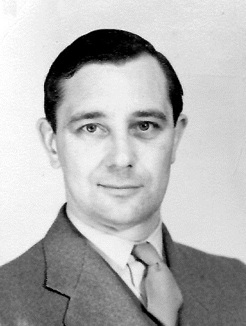 |
|
|
Dr Richard Charles Nairn
1919 West Derby, Lancashire - 1995 Ronkswood, Worcestershire
Associated with the Bon Accord Chess Club in Aberdeen.
Dr R.C. Nairn
Monash University Archives, AustraliaDr Nairn was born in Liverpool to parents who were of Scottish descent.
He accepted a postion as lecturer at the University of Aberdeen in 1952, and this began his 10-year affiliation with the local club, of which he was champion many times.
Because of his professional responsibilities, Dr Nairn had limited opportunities for serious practice. He played in the Scottish championships of 1955 and 1960, both of which were held in Aberdeen, and in his first appearance he finished in second place with 6/7, only a half-point behind the winner, Dr Aitken.
Dr Nairn represented Scotland in the matches against England in 1955 and 1958, and against Ireland in 1957.
He played top board in Richardson Cup matches; in the game below he inflicted Fairhurst's first defeat in 16 years of the competition, in a match won by Bon Accord CC 4½-2½.
Dr R.C. Nairn (Bon Accord) - W.A. Fairhurst (Glasgow)
Richardson Cup
Perth, 27 January 1962
1. e4 e5 2. Nf3 Nc6 3. Bb5 Nf6 4. O-O d6 Fairhurst's favourite defence to the Ruy Lopez throughout his career. 5. d4 Bd7 6. Re1 exd4 7. Nxd4 Be7 8. Nc3 O-O 9. Nxc6 Stronger was 9. Bxc6 bxc6 10. Qd3, or 9. Bf1 Re8 10. Nde2, as Black now gets
an easy game, said Fairhurst. 9... bxc6 10. Bd3 Rb8 Good alternatives were 10...Re8 and 10...Be6, according to Fairhurst. 11. Qe2 Fairhurst commented that the queen is badly placed here. Better alternatives were 11. Rb1 or 11. b3. 11...Re8 Black
takes immediate advantage of Black's faulty queen move. 12...d5 is threatened, and if 13. e5, then 13...Bd6 14. f4 Ng4 etc. (Fairhurst) 12. h3 A further waste of time, but necessary to prevent ...Ng4. 12...Bf8 13. Qf3 White is now compelled to move the queen again, and Black has obviously a big positional
advantage. (Fairhurst) 13...Nd5 This is good enough, but simpler alternatives which give Black a big advantage are 13...c5, followed by Bc6, and 13...g6, followed by Bg7. (Fairhurst) 14. Nxd5 cxd5 15. Be3 Forced, as Black threatened ...f5, said Fairhurst. 15...dxe4 16. Bxe4 Rxb2 17. Bxa7 Be6 Played under slight time pressure, this move gives away the advantage. After 17... c5 Black has the better game, as 18. Qa3 is answered by 18... Rb4 and 18. Bd5 Be6 19. Bb3 Bxb3 20. Rxe8 Qxe8 21. cxb3 Qe5 22. Qd1 Qf6 23. Qe1 Rxf2 24. Qxf2 Qxa1+ 25. Kh2 Qc3 would be clearly favourite for Black. (Fairhurst) 18. a4 Rb4 Black cannot
play 18... d5 as intended because of 19. Bxd5 etc. 19. a5 Bc8 19... Bc4 was much better. 20. Bc6 Dr Nairn said he should have played the stronger 20. Qd3 at this or his next move, with the advance of QRP. The switch to the K-side attack was less clear.
20... Re7 21. Be3 Ba6 22. Bd5 Qe8 Fairhurst claimed that after 22...c5 his position could have been held. However, that overlooks what Dr Nairn pointed out, that 23. Bg5 was threatened. 23. Bd2 Rb8 24. Bc6 Qd8 25. Bc3 Rxe1+ 26. Rxe1 Qg5 27. Bd5 Qg6 28. Be4 Qg5 29. h4 Qd8 (29... Qxh4 30. Bd5) 30. h5 c5 Overlooking White's crushing reply. 31. Qxf7+ 1-0A detailed biography of Dr Nairn can be found here.
Sources
Glasgow Herald, 2 February 1962, p5.
Aberdeen Evening Express, 9 February 1962, p8; 7 September 1962, p6.Alan McGowan
Archivist/Historian, Chess Scotlandadded 4/3/2021
|
|
